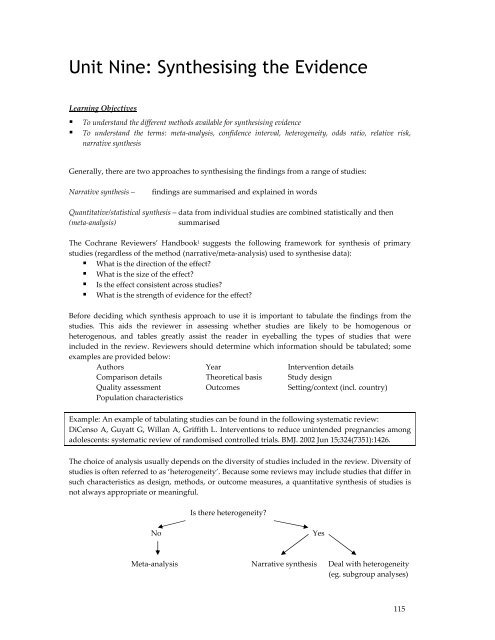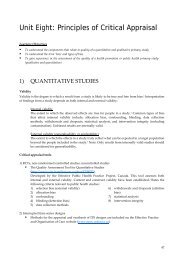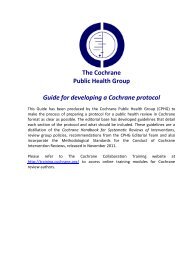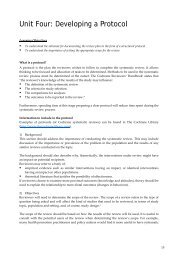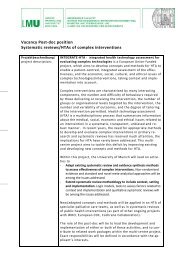Train the Trainer Course book - Cochrane Public Health Group
Train the Trainer Course book - Cochrane Public Health Group
Train the Trainer Course book - Cochrane Public Health Group
Create successful ePaper yourself
Turn your PDF publications into a flip-book with our unique Google optimized e-Paper software.
Unit Nine: Syn<strong>the</strong>sising <strong>the</strong> Evidence<br />
Learning Objectives<br />
To understand <strong>the</strong> different methods available for syn<strong>the</strong>sising evidence<br />
To understand <strong>the</strong> terms: meta-analysis, confidence interval, heterogeneity, odds ratio, relative risk,<br />
narrative syn<strong>the</strong>sis<br />
Generally, <strong>the</strong>re are two approaches to syn<strong>the</strong>sising <strong>the</strong> findings from a range of studies:<br />
Narrative syn<strong>the</strong>sis –<br />
findings are summarised and explained in words<br />
Quantitative/statistical syn<strong>the</strong>sis – data from individual studies are combined statistically and <strong>the</strong>n<br />
(meta-analysis)<br />
summarised<br />
The <strong>Cochrane</strong> Reviewers’ Hand<strong>book</strong> 1 suggests <strong>the</strong> following framework for syn<strong>the</strong>sis of primary<br />
studies (regardless of <strong>the</strong> method (narrative/meta-analysis) used to syn<strong>the</strong>sise data):<br />
What is <strong>the</strong> direction of <strong>the</strong> effect?<br />
What is <strong>the</strong> size of <strong>the</strong> effect?<br />
Is <strong>the</strong> effect consistent across studies?<br />
What is <strong>the</strong> strength of evidence for <strong>the</strong> effect?<br />
Before deciding which syn<strong>the</strong>sis approach to use it is important to tabulate <strong>the</strong> findings from <strong>the</strong><br />
studies. This aids <strong>the</strong> reviewer in assessing whe<strong>the</strong>r studies are likely to be homogenous or<br />
heterogenous, and tables greatly assist <strong>the</strong> reader in eyeballing <strong>the</strong> types of studies that were<br />
included in <strong>the</strong> review. Reviewers should determine which information should be tabulated; some<br />
examples are provided below:<br />
Authors Year Intervention details<br />
Comparison details Theoretical basis Study design<br />
Quality assessment Outcomes Setting/context (incl. country)<br />
Population characteristics<br />
Example: An example of tabulating studies can be found in <strong>the</strong> following systematic review:<br />
DiCenso A, Guyatt G, Willan A, Griffith L. Interventions to reduce unintended pregnancies among<br />
adolescents: systematic review of randomised controlled trials. BMJ. 2002 Jun 15;324(7351):1426.<br />
The choice of analysis usually depends on <strong>the</strong> diversity of studies included in <strong>the</strong> review. Diversity of<br />
studies is often referred to as ‘heterogeneity’. Because some reviews may include studies that differ in<br />
such characteristics as design, methods, or outcome measures, a quantitative syn<strong>the</strong>sis of studies is<br />
not always appropriate or meaningful.<br />
Is <strong>the</strong>re heterogeneity?<br />
No<br />
Yes<br />
Meta-analysis Narrative syn<strong>the</strong>sis Deal with heterogeneity<br />
(eg. subgroup analyses)<br />
115


